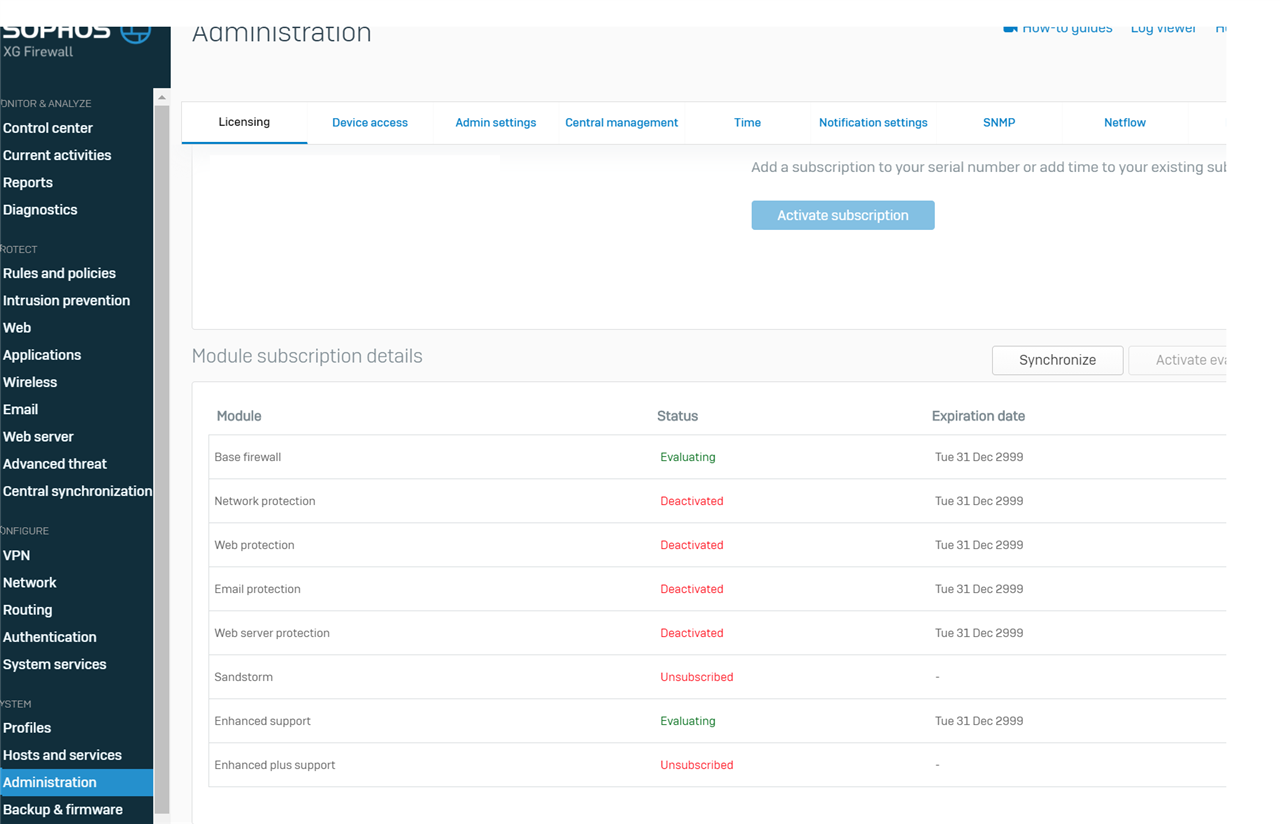Sophos XG Firewall version 18 MR3 How to export users from the Sophos XG Firewall There is a way to Export Users from the Sophos XG Firewall Export locally created users via Sophos XG Firewall UI. Applies to the following Sophos products and versions Sophos XG Firewall SFOS v17.5 MR15 and SFOS v18 MR3. Secure storage master key Default administrator. You can only create the secure storage master key when you sign in using the default administrator's credentials. The XG Firewall provides a default super administrator with the username. Articles Tagged XG Firewall. Sophos Products. XG Firewall v18 performance gains mean more traffic and better security. Sophos Products. XG Firewall v18 MR3 is now available. Sophos Products. Making the most of XG Firewall v18 – Part 6. Sophos Products. Making the most of XG Firewall v18 – Part 5.
The new features and enhancements are on this page.
Sophos Cloud Optix: For XG Firewall instances deployed in the AWS environment, you can see their VPC details in the topology section in Sophos Cloud Optix. For more details, see the Cloud Optix help.
Amazon Web Services: Routing-based redundancy enhancements are available on the AWS platform.
Sophos Central: You can register HA devices with Sophos Central and manage them centrally. Both devices must be on 18.0 MR4. You must configure HA on the web admin console of XG Firewall.
High availability: Improvements to FastPath offload for HA active-passive configurations.
Sophos Connect client:

- The Sophos Connect client menu has been renamed IPsec (remote access). It's available on VPN > IPsec (remote access). You can configure the IPsec remote access configuration on this page. It also offers the advanced settings that were earlier available only through Sophos Connect Admin.
Turning off Use as default gateway on the web admin console may prevent connections from being established if the existing configuration files don't match the advanced settings. If you make changes to any of the advanced settings on the web admin console, you must send the updated .scx file to users for reimport into the Sophos Connect client.
- Users can download the Sophos Connect client from VPN > Sophos Connect client (IPsec and SSL VPN) on the user portal. The available client versions and the remote access connections users can establish are as follows:
- Windows: Sophos Connect client 2.0 (IPsec and SSL VPN connections)
- macOS: Sophos Connect client 1.4 (Currently, only IPsec connections)

For more information, see the remote access VPN help.
Security enhancements:
- SSL VPN: XG Firewall enforces TLS 1.2 for SSL VPN connections:
- Site-to-site connections: Both SSL VPN server and client firewalls must be on 18.0 MR4.
- Remote access connections: These connections use OpenVPN client 2.3.8 and later. The Sophos Connect client 2.0 and legacy SSL VPN client enforce TLS 1.2.
- Password security: Introduced a secure hash for storing the password of the admin (default administrator) account:
- The control center prompts the default administrator to change the current password. We recommend making this change. It's a one-time requirement.
- Password complexity is turned on by default for all passwords, including those for the web admin console and the user portal.
- Open SSL: XG Firewall now uses OpenSSL 1.0.2u.
- SPX portal: A CAPTCHA is now required for the SPX portal to prevent automated attacks. You can't turn it off.
Web: XG Firewall blocks web pages categorized as highly objectionable criminal activity and hides the domain name in logs and reports. It won't implement any policy or exclusion that allows these pages.
RADIUS server: An optional Domain name field, which creates a local entry in the format user@domainname for RADIUS users, is available. The setting eliminates the issue of two entries being created automatically when authentication is based on both AD and RADIUS servers, for example, when the primary authentication method is AD, but VPN or multi-factor authentication uses RADIUS.
Synchronized Application Control: You can also set the automatic cleanup time to one month.
Sophos Xg 18 Mr3 Download
Overview
Sophos Xg 18 Mr3 Price
How to configure
- Login to Sophos XG by Admin account
- Rules and policies -> choose tab NAT rules -> Select Add NAT rule
- Enter Rule name
- In position, choose Top
- In Original source: Specify the pre-NAT source objects of outgoing traffic. To create an inbound NAT rule when the inbound IP address is unknown -> Select Any
- Translated source: IP addresses of the original source objects are translated to the IP addresses that you specify
- To masquerade traffic: Select MASQ
- To create an inbound NAT rule: Select Original
- Original destination: Specify the pre-NAT destination objects of incoming traffic
- To create an outbound NAT rule: Select Original
- Translate destination: IP addresses of the destination objects are translate to the IP addresses or FQDN that you specify
- To create an outbound NAT rule: Select Original
- Original service: Specify the pre-NAT services. Service are a combination of protocols and ports
- To create an outbound NAT rule, this is generally set to Any
- Translated service: Original services are translated to the services that you specify
- If you’ve specified more than one original service or set it to Any, set the translated service to Original
- The translated protocol must match the original protocol. You can translate original service ports to a single or equal number of translated service ports
- You can use this to port forward traffic to internal servers, for example, specify TCP port 443 to forward incoming HTTPS traffic to an internal web server
- Inbound interface: Select the interfaces through which traffic specified in this rule enters XG firewall. For VPNs, set this interface to Any, since VPNs are not interfaces
- Outbound interface: Select the interfaces from which traffic specified in this rule exits XG Firewall. For VPNs and for destination NAT rules that translate public IP addresses to private IP addresses, set this interface to Any
- Select Override source translate for specify outbound interface to apply interface-specific source translation. This option applies only to source NAT rules
- Select the Outbound interface and Translated source
- Select Create loopback policy to allow internal hosts to access other internal hosts
- Select Create reflexive policy to create a mirror policy that reverses the matching criteria of the rule from which it’s created
- Select the NAT method to load balance traffic among the translated internal hosts
- Round robin: Requests are served sequentially, starting with the server next to the previously assigned server. Use it when you want to distribute traffic equally and don’t require session persistence
- First alive: Incoming requests are served to the primary server (the first IP address of the range). If the primary server fails, requests are forwarded to the next server and so on. Use it for failover
- Random: Requests are served randomly to the servers with equal load distribution. Use this when you want equal distribution and don’t require session persistence or order of distribution
- Sticky IP: Traffic from a specific source is forwarded to the mapped server. Use this when you want the requests to be processed by the same server
- One-to-one: Requests are sent to the mapped IP addresses. The IP addresses of the original and translated destinations must be equal in number
- Select Health check to enforce server failover. Specify the probe interval, response time-out and the number of retries after which to deactivate the host. Health check is enforced by default for First alive NAT method
- Select the Probe method. You can select ICMP (ping) or TCP protocols
- Enter the Port over which to check
- Specify the Probe interval. It’s the interval between health checks
- Specify the Response time-out. The server must respond within this time period to be considered alive
- For Deactivate host after, specify the number of retries
-> Click Save
